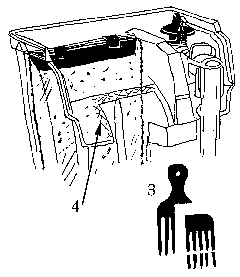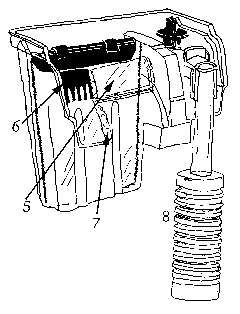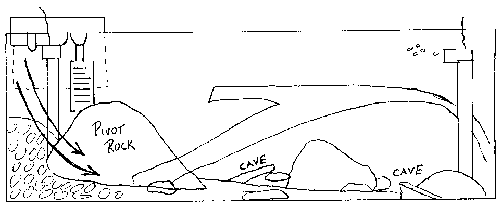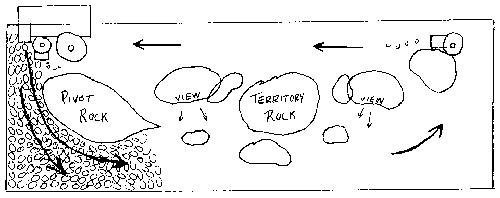Setting Up a Riffle Tank
By Cliff Zollerreprinted from American Currents, Sept. 1997
In recent years, many people have advocated using submerged powerheads to simulate a current for stream dwelling fish. A powerhead, however, may generate a lot of heat, which can be stressful-- or even fatal-- to many cool water natives.
For about 10 years, I've had success keeping and spawning a large number of fish with a system I've developed, adapting a 40-gallon long tank for stream dwellers. I've used it to successfully spawn the orangethroat, johnny, Iowa, rainbow, and fantail darters, and to keep logperch as well as slenderhead, banded and fantail darters for long periods of time. With it, I've also spawned the southern redbelly dace and the common shiner, and kept numerous other kinds of minnows.
The centerpiece of the system is a power filter, modified to direct a smaller, more concentrated water flow into the tank. Most power filters are designed to minimize turbulence. With stream fish, however, you need to maximize turbulence.
I start with a Whisper 4® power filter, carefully cutting out a small rectangle of plastic along the bottom four-fifths of the outflow tray, leaving a chute only about one-fifth the width of the original length of the outflow tray (Fig. 1). Using silicone aquarium sealant, I then attach the edge of the rectangle I've just cut out to the remainder of the upper right-hand four-fifths of the outflow (Fig. 3). This channels all of the filter outflow to the one-fifth of the outflow tray that I didn¹t cut away, sending out a powerful, concentrated jet of water. It¹s also a good idea to remove the plastic spacer from the bottom front of the filter box; this helps direct the water flow towards the front of the tank.
To make it easier to attach the plastic rectangle, I score the surface of the remainder of the outflow tray with a sharp nail (Fig. 2). This allows for better bonding of the plastic with the silicone sealant, which I apply to the scored area when I reattach the rectangle. You may also need to glue a section of plastic comb to the upper edge of the outflow tray, to prevent leapers from jumping into the filter (Fig. 2). Redbelly dace, in particular, love to jump into the power filter and nose-dive into the impeller blades. For added security, I roll up a plastic bag and use it to cover the filter opening in the tank's hood.
I also modify the filter intake tube. First, I drill out the bottom end of the filter strainer (Fig. 1). Then I insert the strainer into a Tetra Super Brilliant Sponge, in essence changing the filter intake tube into a sponge filter (Fig.3). I use the Whisper Biobag and Triad® foam retrofit inserts as filter mediums. (Note: Sponge should be removed and rinsed at least once a week to prevent detritus build-up and maintain flow. Always rinse in aquarium water, as the chlorine in tap water will kill denitrifying bacteria.)
To provide additional biological filtration, I also install an undergravel filter, powered by an air pump. If the gravel spawners lay eggs, I raise the air tubes about halfway up the risers of the undergravel filter, to keep the eggs and fry from being sucked down into the gravel. This allows me to keep it running to prevent the denitrifying bacteria in the gravel bacteria from dying out. The reason I use the undergravel filter in this set up is so that I can shut off the outside filter, to prevent the fry from being pulled ino the sponge.

Fig. 1. 1. Using tin shears, cut square from outflow tray. 2. Drill out end of filter strainer.

Fig. 2. 3. Cut wide-tooth comb as shown. 4. Score outflow tray with sharp nail to ensure strong bond during later application of silicone aquarium sealant.

Fig. 3. 5. Using silicone sealant, affix square previously cut from outflow tray to create partial dam, as shown. 6. Using sealant, affix comb to top of outflow tray, to prevent minnows from swimming into the filter. 7. Apply sealant along edge of outflow try, to create a channel for outflow. 8. Affix Tetra Super Brilliant Sponge to filter strainer.
Generally, I paint the sides and back of the tank black, letting a nice layer of algae grow over everything but the front glass. This seems to calm wild-caught fish. Aesthetically, I like the effect of a darkened fish room, with light coming from only the front glass of the tank.
I arrange the rockwork toward the center of the aquarium, perhaps using the rocks to build caves (Figs. 4 and 5). It¹s important to position the caves so that the occupants¹ view of each other is obstructed, for this reduces territorial squabbles.
To spawn minnows, I put three layers of 1" gravel below the filter outflow. About half of all minnow species spawn over the gravel nests of large minnows, such as chubs or stone rollers. (In addition, some darters that normally spawn on plants and other surfaces will spawn on gravel in the absence of other options, as I've had the Iowa darter do.) Along with approximatingthe spawning conditions in the wild, the gravel functions much like the layer of marbles used to spawn zebra danios and other tropical cyprinids, preventing the parents from eating the eggs. In fact, I usually know when my southern redbelly dace have spawned by the parents' frantic attempts to get at the eggs between the gravel stones.

Fig. 5. Front view of riffle tank set-up, showing 1" gravel sloping down left side of tank, and an arching log to provide security during feeding.

Fig. 6. Top view of riffle tank set-up, showing viewing areas formed by rockwork caves. Note: Avoid dead corners behind undergravel filter tubes, where brine shrimp can be trapped.
To approximate wintering, I try to cool my fish room to 50° for 2-3 months, with day lengths of about six hours. Gradually, I increase the light to approximate the increasing day lengths of spring and summer. Although the increase in light is important, I have to admit that my common shiners, fantail darters, and sunfish all went into spawning mode last October, when we increased the temperature of our house from 65° to 78° (after bringing our new baby home).
For winter chilling, I¹ve found it useful to leave my fishroom windows open about six inches at night. (In the upper Michigan Peninsula, where I live, nighttime winter temperatures often plunge below zero.) I keep out the lowlifes by drilling a hole in each window sash channel, and inserting a large nail into it, which prevents the window from opening any further. I also put a small sign which says "pegged, will not open" outside the window, to save the curious the trouble of slashing my screen to try the window.
It's also possible to skip the over-wintering by catching darters at the beginning of their spawning season. The tendency to spawn in response to warmer indoor temperatures after a cold winter outside is evident among other groups of fish as well, most notably sunfish and sticklebacks. Fish caught just before their normal spring spawning season may comply by spawning for educational displays and photography sessions.
To feed my fish, I switch off the power filter and pour in frozen brine shrimp along the front of the tank, where it can be seen from all the hiding places. Rainbow and johnny darters are good for training new arrivals to eat frozen food. These species don't harass the new fish, the way more territorial species like fantail darters do.
Once newly caught darters are conditioned to eat brine shrimp, you can slowly teach them to emerge from their hideouts by gentle, but persistent, tapping on the tank's painted side at feeding time.
The entire 40-gallon long system costs about $200 to put together. With it, any aquarist with a reasonable amount of skill can keep and spawn many of our native darters and minnows. The power filter modifications also work well with a Whisper 2® power filter and a 20-gallon long tank, although the fish are probably happier with the added room of the 40-gallon long.
Perhaps one of our public aquariums could adopt a similar system for displaying darter and minnow communities, instead of dumping a lot of darters together at the bottom of a tall tank, as seems to be the current practice (if they bother to keep any darters at all).
Used with permission. Article copyright retained by author.